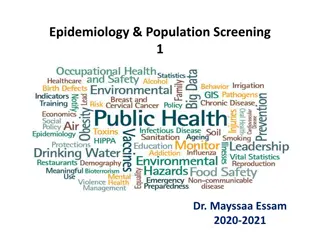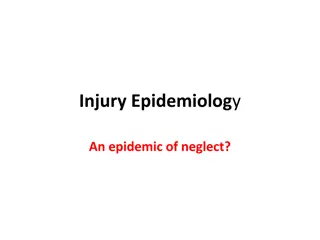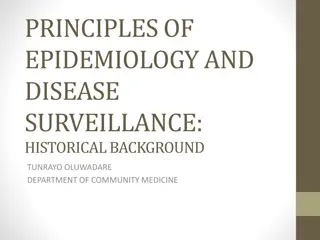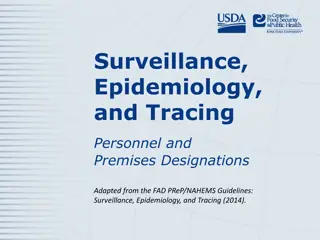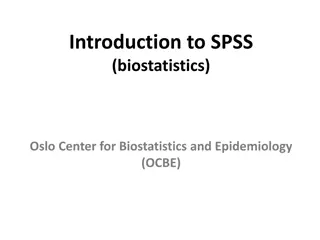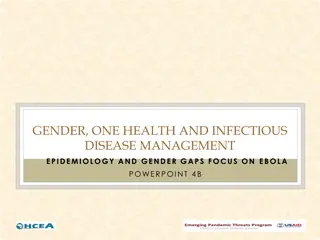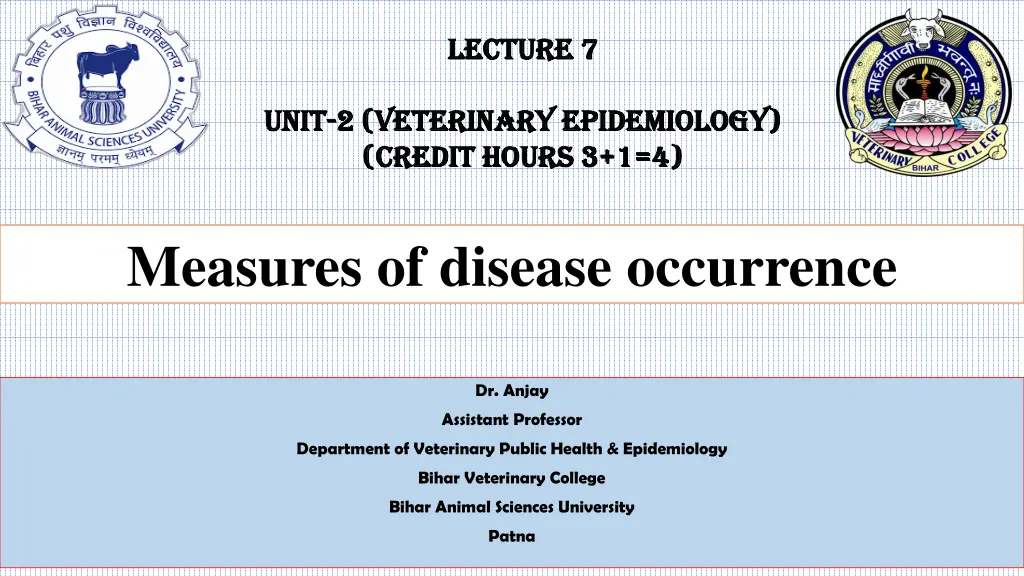
Understanding Measures of Disease Occurrence in Veterinary Epidemiology
Explore the concepts of endemic, epidemic, and sporadic disease occurrences in veterinary epidemiology. Learn how these terms are used to describe the frequency and levels of diseases within populations, including infectious and non-infectious diseases. Gain insights into the factors influencing disease occurrence and the importance of defining the context when using these terms.
Download Presentation

Please find below an Image/Link to download the presentation.
The content on the website is provided AS IS for your information and personal use only. It may not be sold, licensed, or shared on other websites without obtaining consent from the author. If you encounter any issues during the download, it is possible that the publisher has removed the file from their server.
You are allowed to download the files provided on this website for personal or commercial use, subject to the condition that they are used lawfully. All files are the property of their respective owners.
The content on the website is provided AS IS for your information and personal use only. It may not be sold, licensed, or shared on other websites without obtaining consent from the author.
E N D
Presentation Transcript
Lecture 7 Lecture 7 UNIT UNIT- -2 (VETERINARY EPIDEMIOLOGY) 2 (VETERINARY EPIDEMIOLOGY) (Credit Hours 3+1=4) (Credit Hours 3+1=4) Measures of disease occurrence Dr. Anjay Assistant Professor Department of Veterinary Public Health & Epidemiology Bihar Veterinary College Bihar Animal Sciences University Patna
Some basic terms Endemic occurrence 'Endemic' is used in two senses to describe: 1. the usual frequency of occurrence of a disease in a population; 2. the constant presence of a disease in a population. A stable state: in well understood disease:- endemic level is often predictable. The term 'endemic' can be applied not only to overt disease but also to disease in the absence of clinical signs and to levels of circulating antibodies.
The exact context in which the term is used should always be defined. For example, laboratory mice----under conventional systems of 'non-barrier maintenance 100% infected with the nematode Syphacia obvelata------- considered as the usual level of occurrence (endemic level of infection). In contrast, the endemic level of actinobacillosis in a dairy herd is likely to be less than 1%. When a disease is continuously present to a high level, affecting all age-groups equally, it is hyperendemic.
'Endemic' is applied not only to infectious diseases but also to non-infectious ones: For example, the veterinary meat hygienist is just as concerned with the endemic level of carcass bruising as is the veterinary practitioner with the endemic level of pneumonia in pigs. When endemic disease is described, the affected population and its location should be specified. For example, bovine tuberculosis is endemic in badgers in south-west England, the infection apparently is not endemic in all badger populations in the UK.
Epidemic occurrence 'Epidemic' originally was used only to describe a sudden, usually unpredictable, increase in the number of cases of an infectious disease in a population. In modern epidemiology, an epidemic is an occurrence of an infectious or non- infectious disease to a level in excess of the expected (i.e., endemic) level. An epidemic need not involve a large number of individuals. When an epidemic occurs, the population must have been subjected to one or more factors that were not present previously.
Sporadic occurrence A sporadic outbreak of disease is one that occurs irregularly and haphazardly. This implies that appropriate circumstances have occurred locally, producing small, localized outbreaks. 'Sporadic' can indicate either a single case or a cluster of cases of a disease or infection (without obvious disease) that is not normally present in an area.
Pandemic occurrence A pandemic is a widespread epidemic that usually affects a large proportion of the population. Many countries may be affected. For example, pandemics occurrence of rinderpest, foot-and-mouth disease, African swine fever, parvovirus infection, plague (the Black Death), cholera, influenza, COVID-19 etc.
Outbreaks The Office International des Epizooties defines an outbreak as 'an occurrence of disease in an agricultural establishment, breeding establishment or premises, including all buildings as well as adjoining premises, where animals are present'. The term generally implying that several animals are affected. Livestock in developed countries are usually kept as separated populations and so 'outbreak' can be applied unambiguously to an occurrence of disease on an individual farm.
The term sometimes also is used in the context of a single source, irrespective of the number or premises involved. An outbreak is considered as occurring in part of a territory in which, taking local conditions into account. It cannot be guaranteed that both susceptible and non-susceptible animals have not had direct contact with affected or susceptible animals.
Basic concepts of disease quantification A necessary part of the investigation of disease in a population: The counting of affected animals so that the amount of disease can be described. Desirable to describe when and where disease occurs, and Desirable to relate the number of diseased animals to the size of the population at risk of developing disease so that a disease's importance can be assessed.
The amount of disease is the morbidity (Latin: morbus = disease). The number of deaths is the mortality. The times of occurrence of cases of a disease constitute its temporal distribution. The places of occurrence comprise its spatial distribution. The measurement and description of the size of populations and their characteristics constitute demography (Greek: demo= people; -graphia = writing, description).
Measures of disease occurrence Prevalence (P) It is the number of instances of disease or related attributes (e.g., infection or presence of antibodies) in a known population, at a designated time, without distinction between old and new cases. When the time is not specified, prevalence usually refers to point prevalence; that is, the amount of disease in a population at a particular point in time.
Period prevalence refers to the number of cases that are known to have occurred during a specified period of time; for example, a year (annual prevalence). It is the sum of the point prevalence at the beginning of the period and the number of new cases that occur during the period. Can be used when the exact time of onset of a condition is not known (e.g., some behavioural condition) Lifetime prevalence is the number of individuals known to have had disease for at least part of their life
Prevalence can be defined simply as the number of affected animals. It is most meaningful when expressed in terms of the number of diseased animals in relation to the number of animals in the population at risk of developing the disease: number of individuals having a disease at a particular point in time P= number of individuals in the population at risk at that point in time Prevalence can take values between 0 and 1, and is dimensionless. Sometimes, it is expressed as a percentage.
Incidence It is the number of new cases that occur in a known population over a specified period of time. The two essential components of an incidence value are: 1. the number of new cases; 2. the period of time over which the new cases occur. Incidence, like prevalence, can be defined simply in terms of the number of affected animals, but again is usually expressed in relation to the population at risk.
Cumulative incidence (CI): Also termed risk: is the proportion of non-diseased individuals at the beginning of a period of study that become diseased during the period: number of individuals that become diseased during a particular period CI= number of healthy individuals in the population at the beginning of that period It is therefore a proportion that can take values between 0 and 1 (or 0-100%), and is dimensionless.
Cumulative incidence is an indication of the average risk of developing disease during a particular period, in both the individual and the population. It is usually calculated only for the first occurrence of a disease (rather than for multiple occurrences). When calculating cumulative incidence, additional animals at risk cannot be added to the initial number at risk during the period of observation.
Incidence rate (I) It measures the rapidity with which new cases of disease develop over time: number of new cases of disease that occur in a population at particular period of time I= the sum, over all individuals, of the length of time at risk of developing disease The denominator is measured as 'animal-years at risk This is the sum of the periods of observation for each animal during which the latter is free from the disease i.e., is at risk. As soon as an animal becomes diseased, it no longer contributes to this value.)
For example, six cows, free from disease, observed for 1 year would constitute 6 animal- years at risk; equally, one cow observed for 6 years would constitute 6 animal-years at risk. Incidence rate has a dimension, time-1; Incidence rate is calculated per animal-week, per animal-year, and so on. This unit of time is sometimes termed the internal time component.
Attack rate Sometimes a population may be at risk for only a limited period of time: either because exposure to a causal agent is brief, or because the risk of developing the disease is limited to a narrow age range such as the neonatal period. In these circumstances, when the period of risk is brief, the term attack rate is used to describe the proportion of animals that develop the disease. Secondary attack rate is the proportion of cases of a transmissible disease that develop as a result of contact with the primary case:
number of individuals exposed to the primary case that develop disease within the range of the incubation period Secondary attack rate= total number of individuals exposed to the primary case
THANKS FOR KIND ATTENTION






